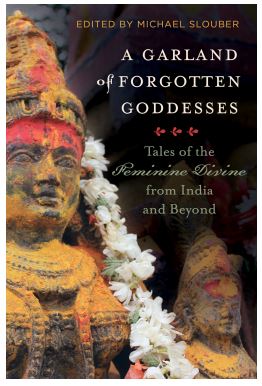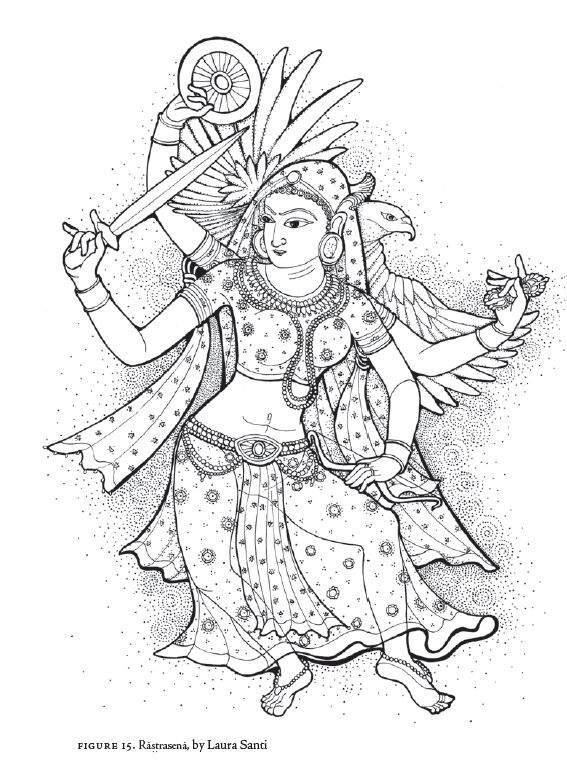Book Review: A Garland of Forgotten Goddesses
Indian goddess traditions are of enduring and fascinated attention to scholars and esoteric practitioners alike, yet many of them are virtually unknown beyond the boundaries of regional traditions or have been ignored. An attempt to redress this lacuna is this new anthology, edited by Michael Slouber – A Garland of Forgotten Goddesses: Tales of the Feminine Divine from India and Beyond (University of California Press 2020, 374 pages, Illustrated). Featuring primary translations of the narratives pertaining to twelve relatively unstudied Hindu goddesses. In what sense are these goddesses “forgotten” though? It is certainly not that they are insignificant, but that they are rarely given space in surveys of Hindu goddesses, or that their local, regional character has been lost as the goddess has become identified with more popular forms. Moreover, the scriptural sources which are the basis of these goddesses’ stories have, for the most part, received little attention. These range from some of the less well-known Purāṇas, the early Tantras, and contemporary oral lore and performance.
The book, as a “Garland” is structured botanically – foregrounding the centrality of “garland” as a central metaphor in Indian poetics and theology. Each chapter opens with a brief introduction to each goddess and the source text, as well as suggestions for how to analyze the text. Then follows the text and its English translation, the idea being that the reader should engage with the text itself, without the scholar’s interpretation getting in the way. This very much resonates with me, as my tantric initiators taught me to do things first, and only try and analyze or contextualize them after I had experienced them directly. Following the text and its translation, we get the essay, which seeks to place a particular goddess (or group of goddesses) in context. In keeping with the “garland” theme, each essay is divided into three sections: seed, flower, and fruit. The “seed” section focuses on the origins and early precursors of the goddess. The “flower”, her flourishing and rise in popularity, and the “fruit” section, either her waning popularity or her absorption into a new identity, as in the process of Sanskritization. Following each essay are bibliographic references on the particular source text chosen, suggestions for further reading, and chapter notes.
A Garland of Forgotten Goddesses is thematically divided into three sections. The first is “Demons and Battles” and focuses on goddesses who are slayers of demons and warriors. First, Noor van Brussel introduces a goddess popular in Kerala – Bhadrakāḷī, offering a translation of two chapters from the Bhadrakāḷī Māhātmya (“glorification of Bhadrakāḷī”), a regional Purāṇa. Caleb Simmons then considers two sister-goddesses from the South Indian city of Mysuru – Cāmuṇḍi and Uttanahaḷḷi, their story based on two songs from the Kannada folk ballad Beṭṭada Cāmuṇḍi. Judit Törzsök follows with her examination of Kauśikī, with a story translated from the thirteenth-century Kashmiri scholar Jayadratha’s Haracaritacintāmaṇi – “The Magic Jewel of Śiva’s Deeds”. The final chapter in this section is by Shaman Hatley and sheds some much-needed light onto the Seven Mothers – the sapta mātaraḥ. Their stories are taken from the Skanda Purāṇa and the Devī Purāṇa.
The second section is entitled “Miracles and Devotees”, and the focus turns away from cosmic battles to more worldly concerns, such as the miraculous powers of the goddess; and how she intercedes on behalf of her devotees. Jessica Vantine Birkenholtz opens this section, with a chapter on Svasthānī, a goddess of the Kathmandu Valley of Nepal, and her narrative from The Story of the Ritual Vow to the Goddess Svasthānī, which illustrates the reasons and rewards for worshipping this goddess. In the next chapter, R. Jeremy Saul introduces Kailā Devī from Rajasthan, widely revered for her interventions in the lives of her devotees. The accompanying narrative is drawn from a local pilgrimage text, Śrī Kailādevī Itihās. Next, Darry Dinnel examines Bahucarā Mātā, a popular goddess from Gujurat. The text is translated from a contemporary devotional work and hints at the goddess’ power to change the gender of her devotees. For chapter 8, Adam Newman considers a goddess from the Mewar region of southern Rajasthan, sometimes called Rāṣṭraśyenā – “Hawk of the Kingdom” or Rāṣṭrasenā – “Army of the Kingdom”. She is visualized either in the form of a hawk or as a woman bearing weapons in her four arms. Her story is told in two chapters from the Ekaliṅga Māhātmya, another regional Purāṇa, which includes the procedures for her worship, including tantric elements.
The third section of A Garland of Forgotten Goddesses is titled “Tantras and Magic”, and as one might suppose, goddesses of the tantric traditions and sorcery are highlighted. First up is Thomas M. Hunter and Wayan Pasek Ariarti’s examination of a Balinese goddess of sorcery, Rangda, and her story as recounted in the Calong Arang. Michael Slouber then introduces the goddess Tvaritā, whose story is found in the Tvaritāmūlasūtra, a Tantra from the Kathmandu Valley thought to date from the twelfth century. She commands both the gods and troops of yoginīs. There follows Anna Golovkova’s examination of Kāmeśvarī, the Goddess of Desire. In support, Golovkova provides a selection of visualizations and hymns of praise to Kāmeśvarī. Two are from the Nityākaula, the sole surviving text of the Nityā tradition (the precursor to contemporary Śrīvidyā) and three from the Vāmakeśvarīmata, which links the goddess to the Śrīcakra. Finally, Olga Serbaeva presents a look at Avyapadeśyā, an esoteric form of Kālī from the voluminous Jayadrathayāmala. The text is an example of apophatic theology, describing the goddess by focusing on what she is not, as opposed to what she is, and so emphasizing her ultimacy.
All in all, A Garland of Forgotten Goddesses is a splendid work, bringing together exacting scholarship in a highly readable format, with beautiful illustrations by Laura Santi. A must for anyone who is interested in goddess traditions, particularly those of India, and their rich, complex histories.


